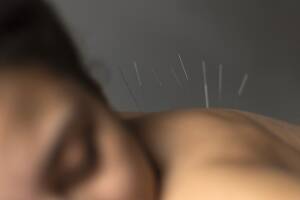Dry needling is a physical therapy that healthcare providers use to treat pain or movement issues associated with muscles.
Dry needling, or trigger point dry needling or intramuscular stimulation, is part of a broader pain management strategy, including exercise, massage, stretching, and other techniques.
In this blog, let’s discuss what dry needling is, how it works, and its benefits for your body.
What is Dry Needling?
During the treatment, the healthcare provider inserts dry, sharp, and sterile needles without any medications into your skin to treat the underlying myofascial pain. As dry needles without any kind of medications are used, it is called Dry Needling.
Myofascial syndrome is a chronic inflammatory condition of the underlying myo (muscles) and fascia ( white connective tissues around the muscles) that can be cured with dry-needling physical therapy.

The myofascial syndrome induced by muscle overuse, muscle trauma, and unaccustomed exercise is often associated with the development of trigger points.
Trigger points are discrete, tender spots developed in the muscles due to repetitive low-level muscle contractions.
How Does It Work?
As a result of inadequate blood supply, the muscle will experience stressful situations due to an energy crisis. Insufficient blood supply, in turn, leads to a lack of oxygen and nutrients to go back to its normal resting state.
In such a situation, the tissue around the trigger points becomes more acidic, and the nerves become hypersensitive, causing the area to become sore and painful.
Physical therapists stimulate those trigger points with a sterile needle, drawing normal blood supply to the area and releasing tension. Moreover, the treatment stimulates the brain to release endorphins, the body’s natural pain-alleviating hormones.
The therapists insert the needle into the skin near the trigger point and rotate it to get a local twitch response, that is, a quick response of the muscle. This response is a positive indication that the muscle is reacting.
Sometimes, patients feel pain alleviation and movement immediately after a dry needling session. It takes two or more sessions to feel the result in other cases.
Does Dry Needling A Painful Treatment?
Dry needling may cause brief discomfort during needle insertion, often described as a pinch or prick. Sensations vary based on individual pain thresholds.
The targeted trigger points may induce a deep ache or muscle twitch, but that is generally part of the therapeutic process. Practitioner skills, communication, and post-needling care influence the overall experience.
While some find it uncomfortable, many report minimal pain. Ultimately, individual responses differ, and open communication with the practitioner helps manage expectations for a more positive experience.
Conditions Treated with Dry Needling:
Dry needling has shown efficacy in addressing various conditions, including:
- Muscle Pain and Spasms
- Chronic Pain Syndromes
- Sports Injuries
- Headaches and Migraines
- Joint Pain and Stiffness
Dry Needling Treatment Procedure
Assessment and Evaluation:
Before commencing the dry needling procedure, a thorough assessment of the patient’s medical history, current symptoms, and physical condition is conducted. This evaluation helps the practitioner identify the specific muscles and trigger points that require attention.
Informed Consent:
Informed consent is crucial in any medical procedure. The practitioner explains the dry needling process, potential benefits, and risks to the patient. This ensures that the patient is fully aware and comfortable with the treatment.
Needle Insertion:
Once the assessment is complete and consent is obtained, the practitioner selects fine, sterile needles. These needles are then inserted into the targeted trigger points in the muscles. The sensation is often described as a brief, mild discomfort, and it’s common for patients to experience a deep ache or muscle twitch response.
Needle Manipulation:
After insertion, the needles may be manipulated by the practitioner. This can involve gentle movements or stimulation of the needles to enhance the therapeutic effects. The goal is to release tension, improve blood flow, and prompt the body’s natural healing processes.
Post-Needling Care:
After the needles are removed, the practitioner may recommend specific post-needling care, such as rest, hydration, or gentle stretches. Patients need to follow these instructions to maximize the benefits of the treatment.
Benefits Of Dry Needling Physical Therapy
Experience the full benefits of dry needling therapy from our qualified and experienced chiropractors at ASAP.
- Pain Relief: Dry needling targets trigger points, causing a local twitch response releasing endorphins. This alleviates pain by disrupting the pain cycle and reducing muscle spasms, making it effective for musculoskeletal issues.
- Improved Range of Motion: By releasing muscle tension and addressing restrictions, dry needling helps improve flexibility and increases the range of motion in joints, making daily activities and exercises more comfortable and efficient.
- Accelerated Healing: Microtrauma caused by the needles stimulates blood flow, promoting the delivery of oxygen and nutrients to the targeted areas. This enhances the body’s natural healing processes, aiding in recovering damaged or injured tissues.
- Reduced Muscle Tension: Precise needling into trigger points helps release muscle knots, relieving muscle tension. This promotes relaxation and reduces stiffness, improving muscle function and comfort.
- Complementary to Other Therapies: Dry needling can be integrated into comprehensive rehabilitation plans, working cooperatively with physical therapy, exercise, and other therapeutic modalities. This offers a holistic approach to recovery, addressing multiple aspects of musculoskeletal health for optimal outcomes.
Risks Associated With Dry Needling And Management Methods
Here are some of the risks that are associated with dry needling and management methods:
Bruising and Soreness:
Risk: Needle insertion may cause bruising or soreness.
Management: Practitioner advice on post-treatment care, including ice application.Pain During Treatment:
Risk: Discomfort or pain during needle insertion or manipulation.
Management: Open communication with the practitioner for adjustments.Dizziness or Fainting:
Risk: Sensations may cause dizziness or fainting.
Management: Immediate communication with practitioners; adjustments as needed.Post-Treatment Fatigue:
Risk: Temporary fatigue or drowsiness after a session.
Management: Rest, hydration, and scheduling sessions allowing for relaxation.Risk of Infection:
Risk: Rare risk of infection at needle insertion sites.
Management: Ensuring sterile needles and proper hygiene.Nerve Injury:
Risk: Rare risk of hitting a nerve during needle insertion.
Management: Practitioner training and patient choice of qualified professionals.Adverse Reactions:
Risk: Potential adverse reactions to the treatment.
Management: Thorough pre-treatment assessment and consultation with healthcare professionals,
Conclusion :
Dry Needling, is a safe and effective therapeutic approach in the world of pain management and rehabilitation. Its ability to target specific trigger points, coupled with a holistic understanding of musculoskeletal health, makes it a valuable tool for those seeking relief from various conditions.
If you’re considering dry needling, consult our qualified healthcare professionals at ASAP and Rehab to understand the detailed procedure of the treatment and how it can be customized to meet your unique needs, leading to a holistic well-being.
Dr. Stephen Jung
Dr. Stephen Jung was born and raised in Houston, Texas, and graduated from the University of Texas at Austin in 2007 where he found his passion for sports medicine. In 2014, he graduated from Texas Chiropractic College and began doing rotations at different sports medicine clinics across Houston. Dr. Jung believes our mission is to provide the best treatment model that is specific to each individual that comes in.



1 Comment
Comments are closed.